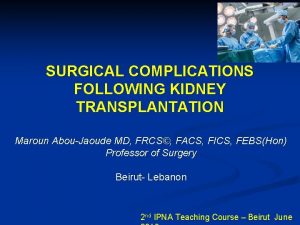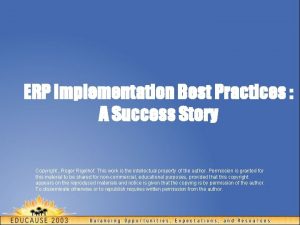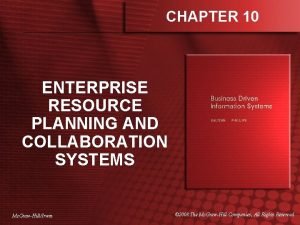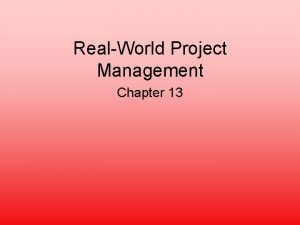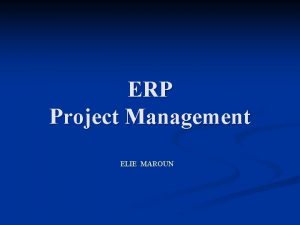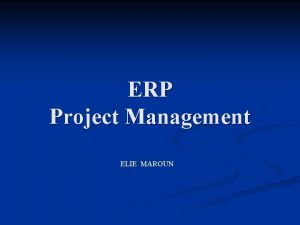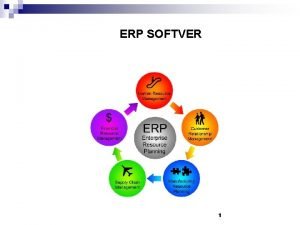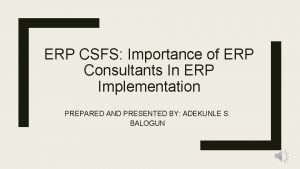ERP Project Management ELIE MAROUN Characteristics of ERP

















- Slides: 17

ERP Project Management ELIE MAROUN

Characteristics of ERP Installation projects n ERP systems involve a large collection of complex hardware and software n ERP project management has been found to benefit most due to the following: n Clear definition of objectives n Development of a work plan and a resource plan n Careful tracking of progress

Characteristics of ERP Installation projects Project plans need to be more aggressive because ERP systems are very critical to organizational efficiency. n Scope creep? n How can it be avoided n What is it n

Characteristics of ERP Installation projects n What’s more important? n n Implementing an ERP system on time and budget Implementing the right ERP system

Critical Path Method n Provides an easy way to identify how fast a project can be completed. Input of the CPM include: § § § A list of each activity Expected duration Activities that immediately precede the activity

Critical Path Method Two Graphical outcomes of the Critical Path Method are: 1. Network diagram 2. Gantt Chart

Critical Path Method n Steps in CPM project planning: 1. 2. 3. 4. 5. 6. Specify individual activities Determine sequence of those activities Draw a network diagram Estimate completion time for each activity Identify Critical Path (longest path through network) Update the CPM diagram as the project progresses

Critical Path Method n Network Diagram

Critical Path Method n Gantt Chart

Critical Path Method Definitions to be familiar with: § Early Start Schedule- Schedule designed to accomplish each task as early as possible. § Late Start Schedule- Schedule designed to accomplish each task as late as possible while maintaining expected project completion time. § Slack- Extra time available to accomplish a task beyond the time scheduled, while still allowing the project to be completed as scheduled. § Shared slack- Slack that is common to two tasks.

Buffers Means to ensure that critical activities are completed on time n A time that is included in the schedule to protect against unanticipated delays and to allow early starts n

Buffers n Different types: n n Project Buffers- Added to the end of a project to ensure against general delays. Feeding Buffers- Buffers preceding the juncture of non critical activities leading into critical activities. (this ensures that the NC will not delay the C activities) Resource Buffers- Placed before resources scheduled to work on critical activities to ensure that resources shortage will not delay critical activities. Strategic Resource Buffers- Used to ensure that key resources are available for critical activities.

Resource Leveling Involves extending schedules so that particular resources are not over scheduled. n Leveling requires delaying tasks until resources are available, allowing the project to be finished, though often resulting in a later project finish date. n n Ex. Limited resource availability or difficult to manage changes in resource levels.

Critical Path Criticisms The Critical Path is very useful in identifying the fastest one can expect to complete a project, but very often things may not proceed as planned in ERP projects. The original Critical Path Plan, always requires some kind of adjusting especially as the project moves forward through each phase. n There is usually significant variance in possible durations of activities. n One way to help in dealing with high uncertainty in activity progress is scheduling milestones.

Critical Path Criticisms n Ways to help in analyzing projects and their time and resources requirements are: Crashing – trade-off between time and resource n PERT – Project Evaluation and Review Technique (uncertainty in duration estimates) n Simulation- to better deal with uncertainty in duration estiamtes n

Critical Path Criticisms n Resource smoothing – an extension of resource leveling n Tends to make projects longer, not shorter.

Works Cited n n n http: //www. netmba. com/operations/project/cpm/ http: //www. smartdraw. com/resources/examples/busin ess/gantt 1. htm http: //www. pmforum. org/library/glossary/PMG_R 03. htm http: //pubs. logicalexpressions. com/Pub 0009/LPMArti cle. asp? ID=213 http: //www. comp. glam. ac. uk/Teaching/projectmanag ement/planning 3 f. htm Managerial issues of Enterprise Resource Planning systems
 Maroun abou jaoude
Maroun abou jaoude Wissam maroun
Wissam maroun Introduction for project
Introduction for project Erp implementation best practice
Erp implementation best practice Core and extended erp components
Core and extended erp components The role of project management in achieving project success
The role of project management in achieving project success Process discriminants in software project management
Process discriminants in software project management How to reduce project duration
How to reduce project duration Introduction to project management kathy schwalbe
Introduction to project management kathy schwalbe What is strategic assessment in software project management
What is strategic assessment in software project management When conducting post project audits
When conducting post project audits Ms project agile template
Ms project agile template Types of terminations
Types of terminations Characteristics of project management
Characteristics of project management Elie metchnikoff probiotics
Elie metchnikoff probiotics Night elie wiesel symbolism
Night elie wiesel symbolism Night by elie wiesel chapter 5
Night by elie wiesel chapter 5 Night chapter 2 quiz
Night chapter 2 quiz
